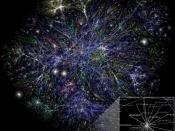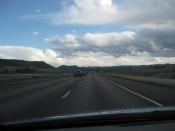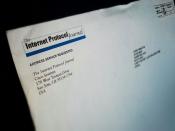Introduction ? What is TCP/IP How TCP/IP works Application of TCP/IP Conclusions References Additional information: My report plan Understanding TCP/IP 1.0 INTRODUCTION This appendix discusses the TCP/IP architecture and provides a basic reference model that can help us to understand the importance of TCP/IP in the development of the Internet. It explains TCP/IP terminology and describes the fundamental concepts underlying the TCP/IP protocol suite. Generally, TCP/IP is described using three to five functional layers. To describe TCP/IP based firewalls more precisely, we have chosen the common DoD reference model, which is also known as the Internet reference model. The figure below illustrates the Internet reference model.
1.1 WHAT IS TCP/IP The name TCP/IP is derived from only two of the dozens of protocols that compose the suite which are the Transmission Control Protocol (TCP) and the Internet Protocol (IP).
TCP/IP originated out of research into networking protocols that the Department of Defense (DoD) initiated in 1969.
In 1968, the DoD Advanced Research Projects Agency (ARPA) began researching the network technology that is now called packet switching The original focus was to facilitate communication among the DoD community. However, the network that was initially constructed as a result of this research, called ARPANET, gradually became known as the Internet. The TCP/IP protocols played an important role in the development of the Internet by becoming the standard protocols for ARPANET.
Due to the history of the TCP/IP protocol, it is often referred to as the DoD protocol suite or the Internet protocol suite.
4 Process/application layer consists of applications and processes that use the network.
3 Host-to-host transport layer provides end-to-end data delivery services.
2 Internetwork layer defines the datagram and handles the routing of data.
1 Network access layer consists of routines for accessing physical network.
2.0 HOW TCP/IP...


